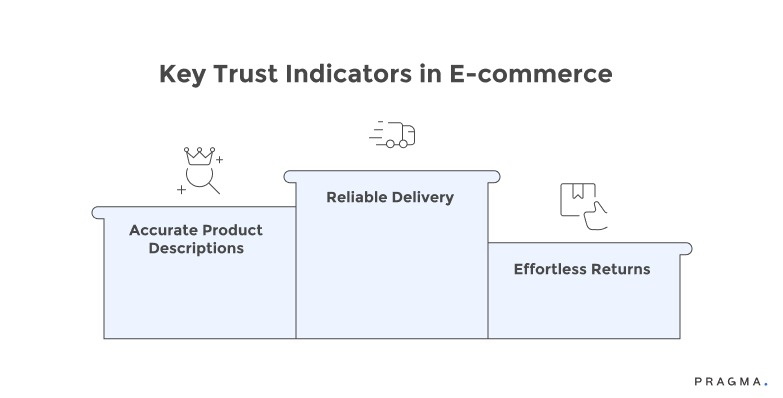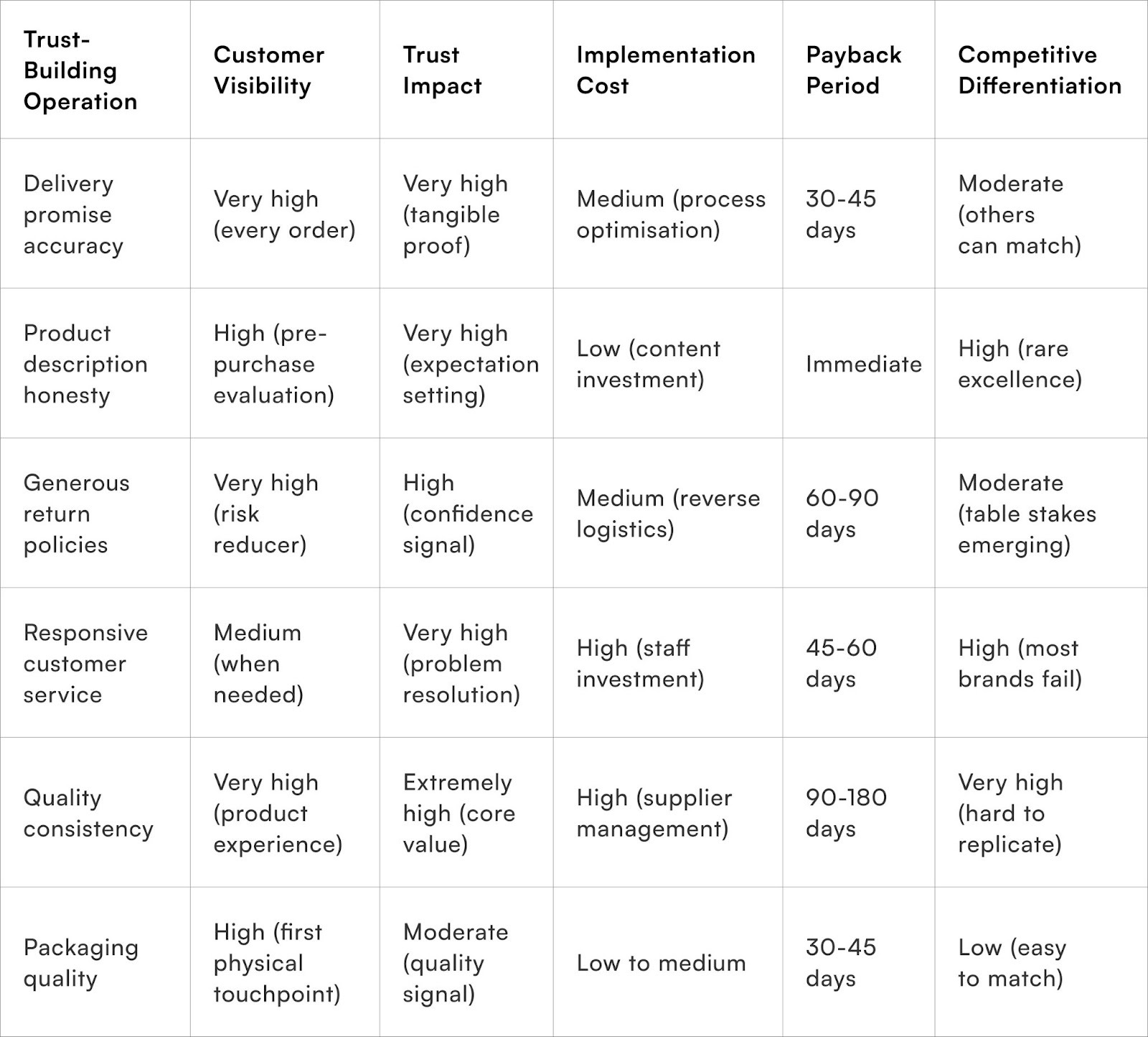In the crowded and price-sensitive Indian e-commerce space, many brands feel compelled to rely heavily on discounts and flash sales to grab customer attention and boost short-term sales. While this can drive traffic, over-reliance on deep price cuts often erodes margins, commoditises the brand, and trains customers to wait for sales instead of buying at full price. More critically, discount-led growth strategies rarely build lasting customer trust or loyalty.
Today’s savvy Indian D2C consumers expect more than just bargains—they demand transparency, reliable service, consistent product quality, and personalised experiences. Brands that invest in these trust-building pillars can differentiate themselves sustainably without resorting to constant discounting, creating higher lifetime value and meaningful brand equity.
This blog explores how Indian brands Building Customer Trust Without Heavy Discounts and can foster genuine customer trust through operational excellence, clear communication, social proof, and value-added engagement—all strategies proven to boost conversion and retention without sacrificing profitability. For businesses looking to grow responsibly and build enduring customer relationships, trust is the new currency—and it’s attainable without slashing prices.
Why do discounts fail to build lasting customer relationships?
Price-based acquisition attracts deal-seekers rather than brand believers, creating dependency cycles that destroy margins without generating loyalty

Discount psychology trains customers to question full-price value propositions. Customers purchasing products at 40% off mentally anchor to discounted prices as "real" value with full prices representing overcharging they should avoid.
This reference point corruption makes full-price sales increasingly difficult as customers internalise that "smart shoppers wait for sales." The conditioning creates adverse selection where only discount-insensitive customers buy at full price—typically lower-engagement bargain hunters—whilst brand enthusiasts who might pay premium delay purchases awaiting inevitable promotions.
Self-selection bias means discount-driven acquisition captures inherently less loyal customers. Shoppers motivated primarily by price demonstrate 67-73% lower repeat purchase rates than value-driven buyers across categories.
The fundamental difference lies in decision-making basis: price-motivated customers will switch brands for ₹50 savings whilst value-motivated customers remain loyal through price fluctuations because they purchase for reasons beyond cost.
Building customer base through heavy discounting systematically selects for least-loyal segment whilst repelling customers who might become advocates through quality and service excellence.
Margin compression from sustained discounting eliminates investment capacity in quality, service, and innovation—the actual trust-building activities. Brands operating at 12-18% EBITDA can fund excellent customer service, generous return policies, quality improvements, and innovation.
Those at 2-6% EBITDA due to discount spending must cut corners, creating experiences that fail to justify even discounted prices, much less full value. The economic trap destroys the ability to deliver experiences that build genuine trust independent of promotional incentives.
Competitive dynamics trap brands in perpetual discount escalation. Once competitors establish discount expectations, exiting requires absorbing conversion drops that most brands cannot tolerate.
The industry-wide race to bottom becomes self-reinforcing—brands cannot unilaterally stop discounting without losing customers to competitors still offering deals. Breaking free requires a differentiated value proposition strong enough that customers choose brands for reasons beyond price, demanding strategic repositioning that most discount-addicted brands cannot execute.
What operational excellence demonstrates reliability better than promises?
Consistent delivery of basic expectations builds trust foundation that marketing messages cannot replicate
Building Customer Trust: Key Pillars Beyond Price

1. Delivery Promise Accuracy:
This is often the most visible and impactful trust indicator. Brands that consistently deliver within or even ahead of their promised timeframe (e.g., 3-4 days for a "3-5 day" promise) build strong trust through demonstrated reliability. Conversely, failing to meet promised delivery windows, even with high-quality products, erodes credibility.
Predictability in delivery, enabling customers to plan effectively, is valued more highly than overly optimistic promises that lead to disappointment. A reliable 7-day delivery often outperforms an unreliable 3-day promise in terms of trust perception.
2. Product Description Accuracy:
Trust is forged at the moment of unboxing when customer expectations meet reality. Detailed, honest product descriptions, complemented by clear photography, precise material specifications, and realistic use-case guidance, are essential to prevent expectation gaps that lead to returns and complaints.
Brands that intentionally under-promise and over-deliver—describing products conservatively while the actual quality exceeds those descriptions—generate positive surprise and build significant trust. In contrast, overselling products through manipulated photos and exaggerated descriptions fosters distrust, even if the product objectively meets certain standards but falls short of inflated expectations.
3. Effortless Return and Exchange Processes:
Offering a hassle-free return and exchange policy signals confidence in product quality and significantly reduces purchase risk for customers. Brands that provide "no-questions-asked" returns, prepaid return shipping, and swift refund processing demonstrate this confidence, thereby encouraging purchases.
Paradoxically, generous return policies can actually decrease return rates by 18-24% because customers feel secure in their buying decisions. Conversely, difficult return processes can increase return rates by 31-38% as customer anxiety drives defensive returns. The operational investment in easy returns ultimately pays dividends through increased conversion rates and a reduction in actual return volume.
4. Responsive and Effective Customer Service:
Trust is profoundly strengthened when brands demonstrate genuine care during challenging moments. Brands that respond to customer queries within four hours, resolve issues in a single interaction over 65% of the time, and proactively communicate during problems can transform negative experiences into loyalty-building opportunities.
Poor service—characterised by 24+ hour response times, multiple interactions to resolve an issue, or defensive blame-shifting—can quickly dismantle trust built over numerous positive transactions. Investment in exceptional customer service powerfully communicates customer prioritization in a way that price discounts simply cannot.

How does transparent communication build credibility?
Honest information sharing about products, processes, and challenges establishes authenticity that marketing polish cannot achieve
Building Customer Trust: Strategies Beyond Discounts
1. Transparency in Manufacturing and Sourcing:
Customers are increasingly curious about product origins and ethical production. Brands can cultivate trust by openly sharing:
- Factory locations and material sourcing details: Demonstrates ethical standards.
- Production processes and quality control methods: Builds credibility through openness.
- Detailed "About Our Products" content: For example, explaining that "Our kurtas use 100% cotton sourced from Gujarat mills, dyed using eco-friendly processes, and stitched in our Bangalore facility with fair labour practices" fosters connection and trust.
This level of transparency differentiates brands from competitors who might conceal supply chain details, implying something to hide.
2. Transparency in Pricing:
Helping customers understand product value beyond just the price tag is crucial. Brands can achieve this by:
- Explaining cost structures and margin logic: For instance, detailing "₹480 materials, ₹220 labour, ₹180 logistics, ₹140 overhead, ₹180 margin = ₹1,200 price" demonstrates fairness and educates customers on production economics.
This openness builds appreciation for pricing and enables informed comparisons. Customers who understand that ₹1,200 represents fair value for a quality product are less price-sensitive than those who only compare numbers without context.
3. Honest Communication and Acknowledgment of Challenges:
Demonstrating integrity during difficulties significantly strengthens customer relationships. Brands should:
- Proactively communicate issues: For example, if facing supply delays, stating "Unexpected fabric shortage delaying production 7-10 days. Your order ships next week, not tomorrow as promised. Sorry for the delay!" maintains trust through honesty.
Hiding problems until customers discover them independently destroys credibility. Vulnerable communication, paradoxically, strengthens relationships by showing respect for customer intelligence and concern for their experience.
4. Authenticity in Customer Reviews:
Displaying genuine customer feedback, including critical comments, proves review legitimacy and demonstrates confidence. Brands should:
- Show unfiltered reviews (positive and negative): Engage with responses to address concerns.
- Respond constructively to criticism: For example, "Thanks for feedback on sizing. We've updated size chart based on your input" proves authenticity and showcases continuous improvement.
Curated reviews with only 5-star ratings can create skepticism, implying manipulation. Real criticism, coupled with constructive brand responses, builds significant trust.
What social proof mechanisms establish credibility beyond paid advertising?
Third-party validation and peer endorsement carry trust weight that brand claims lack
Building Customer Trust: Strategies Beyond Discounts
1. Leverage Authentic Customer Testimonials:
- Verifiable Identity: Prioritize testimonials with clear, verifiable identities over anonymous reviews.
- Rich Details: Enhance credibility with customer photos, full names, verified purchase badges, and location details.
- Video Power: Utilize video testimonials where customers share their experiences in their own words for maximum impact.
- Peer Validation: Enable prospective customers to relate by showcasing testimonials from individuals with similar needs, fostering trust through peer experiences rather than just brand claims.
2. Seek Expert Endorsements:
- Credible Industry Voices: Secure positive mentions and reviews from respected industry experts (e.g., stylists for fashion, dermatologists for beauty, tech reviewers for electronics).
- Independent Assessment: Expert validation provides an objective, third-party assessment that customers trust more than brand marketing.
- Strategic Partnerships: Authentically developed partnerships, such as "Developed with inputs from renowned nutritionist Dr. X," can transfer credibility when genuine and not overtly promotional.
3. Gain Respected Media Coverage:
- Signals Legitimacy: Features in mainstream publications like Economic Times, Vogue, or YourStory demonstrate external validation that advertising alone cannot achieve.
- Independent Deeming: Editorial coverage suggests journalists independently found the brand newsworthy and credible.
- Valuable Narratives: Press mentions are particularly impactful when they discuss the brand's story, founder journey, or product innovation, rather than purely promotional content.
4. Obtain Certification and Accreditation:
- Objective Validation: Display recognized quality standards through certifications (e.g., organic, ISO, Fair Trade).
- Independent Audit: Third-party certification proves quality through independent audits, moving beyond self-proclaimed excellence.
- Transparent Verification: Prominently display certification badges with links to the certifying body, building trust through verifiable information that customers can independently confirm.
How can content marketing establish thought leadership and expertise?
Educational value provision demonstrates knowledge and builds authority that sales messaging cannot achieve
1. Educational Content: Become a Trusted Expert
By creating educational blog content that addresses customer problems and answers their questions, brands can position themselves as helpful experts. This approach builds trust by demonstrating expertise and a customer service mentality, rather than simply trying to sell products.
Examples include
fashion brands offering "Ultimate Guide to Fabric Care,"
beauty brands explaining "Understanding Skin Types and Product Selection," or electronics brands providing a "Technology Comparison Guide."
Such content offers genuine value beyond mere product promotion, leading customers to view brands as knowledgeable partners.
2. How-to Guides and Tutorials: Empower Customers and Showcase Confidence
Detailed how-to guides and tutorials that demonstrate product usage help customers maximize value and show a brand's confidence in its offerings.
Providing guidance like "5 Ways to Style This Kurta," "10-Step Skincare Routine Using Our Products," or "Setting Up Your New Device" improves customer satisfaction and reduces returns and complaints.
This investment in customer success signals product quality, as brands less confident in their products tend to avoid detailed usage instructions that might highlight limitations.
3. Behind-the-Scenes Content: Humanize Your Brand
Sharing behind-the-scenes content that reveals stories about people, processes, and values helps humanise brands and foster emotional connections beyond mere transactions. Content that showcases artisans crafting products, founders explaining their mission, team members sharing expertise, or documentation of the production process builds deeper relationships. Customers connect with authentic stories and people, not faceless corporations. This humanisation generates loyalty that transcends product features and pricing, fostering communities built on shared values rather than just customer bases.
4. User-Generated Content: Build Authentic Social Proof
User-generated content (UGC) campaigns encourage customers to share their experiences, thereby creating authentic social proof and deepening engagement. Photo contests, review incentives, or community showcases that highlight customer stories provide genuine testimonials and make customers feel valued.
This type of content is often more credible than brand-created materials, boosting engagement and loyalty. Customers featured in these campaigns often become brand advocates, sharing content within their networks and defending the brand against criticism.

To Wrap It Up
Building customer trust without heavy discounts requires fundamental mindset shift from transaction optimization to relationship building. The approach demands patience as trust develops gradually through consistent positive experiences rather than instant conversion through price manipulation.
Yet the economic advantages prove overwhelming—customers acquired through value demonstration show 2-3x higher lifetime value, maintain loyalty through price fluctuations, and generate profitable growth enabling continued excellence investment. The strategic discipline of trust-building over discounting separates sustainable brands from those trapped in perpetual subsidy cycles destroying margins whilst building no lasting competitive advantages.
Identify the single operational element where you most frequently fail customer expectations—delivery timing, product quality, service response, or return ease—then invest whatever necessary to achieve consistency there before spending another rupee on discounts.
Long-term success in Indian e-commerce increasingly separates between brands building genuine relationships through delivered value and those competing solely on price in race-to-bottom dynamics.
Market maturation brings customer sophistication demanding quality and service excellence over bargain hunting. Brands establishing trust foundations today position themselves for sustainable growth as discount fatigue sets in and customers seek reliable partners rather than cheapest transactions. The compound advantages of trust-based customer relationships—organic advocacy, reduced CAC, higher LTV, pricing power—create economic moats that discount-dependent competitors cannot cross regardless of funding or marketing spend.
For D2C brands seeking to build sustainable customer relationships beyond discount dependency, Pragma's customer experience platform provides operational excellence monitoring, transparent communication tools, review and social proof management, and loyalty programme frameworks that help brands achieve 34-42% improvement in full-price conversion whilst building 2-3x higher customer lifetime value through trust-based relationships rather than subsidised transactions.
Talk to our experts for a customised solution that can maximise your sales funnel
Book a demo



.png)
.png)